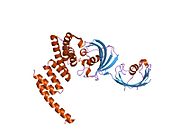Biology:FKBP5
 Generic protein structure example |
FK506 binding protein 5, also known as FKBP5, is a protein which in humans is encoded by the FKBP5 gene.[1]
Function
The protein encoded by this gene is a member of the immunophilin protein family, which play a role in immunoregulation and basic cellular processes involving protein folding and trafficking. This encoded protein is a cis-trans prolyl isomerase that binds to the immunosuppressants tacrolimus (FK506) and sirolimus (rapamycin). It is thought to mediate calcineurin inhibition. It also interacts functionally with mature corticoid receptor hetero-complexes (i.e. progesterone-, glucocorticoid-, mineralocorticoid-receptor complexes) along with the 90 kDa heat shock protein and PTGES3 (P23 protein).[2]
As an Hsp90-associated co-chaperone that regulates the responsiveness of steroid hormone receptors, FKBP51 plays an important role in stress endocrinology and glucocorticoid signaling.[2]
Clinical significance
The FKBP5 gene has been found to have multiple polyadenylation sites[1] and is statistically associated with a higher rate of depressive disorders.[3]
Decreased methylation in the promoter of the FKBP5 gene has been observed in blood samples from patients with neurodegenerative diseases.[4]
FKBP51 Ligands
As a key player in several diseases like stress-related disorders, chronic pain, and obesity, FKBP51 is an attractive drug target. SAFit2 currently the most best characterized FKBP51 ligand, has shown promising effects in numerous animal models.[2] Macrocyclic FKBP51-selective ligands are non-immunosuppressive, engage FKBP51 in cells, and block the cellular effect of FKBP51.[5]
Interactions
FKBP5 has been shown to interact with Heat shock protein 90kDa alpha (cytosolic), member A1.[6]
See also
References
- ↑ 1.0 1.1 "Entrez Gene: FKBP5 FK506 binding protein 5". https://www.ncbi.nlm.nih.gov/sites/entrez?Db=gene&Cmd=ShowDetailView&TermToSearch=2289.
- ↑ 2.0 2.1 2.2 "The Many Faces of FKBP51". Biomolecules 9 (1): 35. January 2019. doi:10.3390/biom9010035. PMID 30669684.
- ↑ "Polymorphisms in FKBP5 are associated with increased recurrence of depressive episodes and rapid response to antidepressant treatment". Nature Genetics 36 (12): 1319–25. December 2004. doi:10.1038/ng1479. PMID 15565110.
- ↑ "Meta-analysis of genome-wide DNA methylation identifies shared associations across neurodegenerative disorders". Genome Biology 22 (1): 90. March 2021. doi:10.1186/s13059-021-02275-5. PMID 33771206.
- ↑ "Macrocyclic FKBP51 Ligands Define a Transient Binding Mode with Enhanced Selectivity". Angewandte Chemie 60 (24): 13257–13263. June 2021. doi:10.1002/anie.202017352. PMID 33843131.
- ↑ "Molecular cloning of human FKBP51 and comparisons of immunophilin interactions with Hsp90 and progesterone receptor". Molecular and Cellular Biology 17 (2): 594–603. February 1997. doi:10.1128/MCB.17.2.594. PMID 9001212.
- ↑ Prakash, Ajit; Shin, Joon; Rajan, Sreekanth; Yoon, Ho Sup (2016-04-07). "Structural basis of nucleic acid recognition by FK506-binding protein 25 (FKBP25), a nuclear immunophilin". Nucleic Acids Research 44 (6): 2909–2925. doi:10.1093/nar/gkw001. ISSN 0305-1048. PMID 26762975.
Further reading
- "Receptor accessory folding helper enzymes: the functional role of peptidyl prolyl cis/trans isomerases". FEBS Letters 495 (1–2): 1–6. April 2001. doi:10.1016/S0014-5793(01)02326-2. PMID 11322937.
- "FKBP51, a novel T-cell-specific immunophilin capable of calcineurin inhibition". Molecular and Cellular Biology 15 (8): 4395–402. August 1995. doi:10.1128/mcb.15.8.4395. PMID 7542743.
- "Two FKBP-related proteins are associated with progesterone receptor complexes". The Journal of Biological Chemistry 268 (24): 18365–71. August 1993. doi:10.1016/S0021-9258(17)46853-0. PMID 7688746.
- "FKBP54, a novel FK506-binding protein in avian progesterone receptor complexes and HeLa extracts". The Journal of Biological Chemistry 268 (32): 24270–3. November 1993. doi:10.1016/S0021-9258(20)80520-1. PMID 7693698.
- "Oligo-capping: a simple method to replace the cap structure of eukaryotic mRNAs with oligoribonucleotides". Gene 138 (1–2): 171–4. January 1994. doi:10.1016/0378-1119(94)90802-8. PMID 8125298.
- "The involvement of p23, hsp90, and immunophilins in the assembly of progesterone receptor complexes". The Journal of Steroid Biochemistry and Molecular Biology 56 (1-6 Spec No): 31–7. January 1996. doi:10.1016/0960-0760(95)00221-9. PMID 8603045.
- "Molecular cloning of human FKBP51 and comparisons of immunophilin interactions with Hsp90 and progesterone receptor". Molecular and Cellular Biology 17 (2): 594–603. February 1997. doi:10.1128/MCB.17.2.594. PMID 9001212.
- "Tissue distribution and abundance of human FKBP51, and FK506-binding protein that can mediate calcineurin inhibition". Biochemical and Biophysical Research Communications 232 (2): 437–43. March 1997. doi:10.1006/bbrc.1997.6307. PMID 9125197.
- "Construction and characterization of a full length-enriched and a 5'-end-enriched cDNA library". Gene 200 (1–2): 149–56. October 1997. doi:10.1016/S0378-1119(97)00411-3. PMID 9373149.
- "Specific binding of tetratricopeptide repeat proteins to the C-terminal 12-kDa domain of hsp90". The Journal of Biological Chemistry 273 (29): 18007–10. July 1998. doi:10.1074/jbc.273.29.18007. PMID 9660753.
- "DNA cloning using in vitro site-specific recombination". Genome Research 10 (11): 1788–95. November 2000. doi:10.1101/gr.143000. PMID 11076863.
- "Toward a catalog of human genes and proteins: sequencing and analysis of 500 novel complete protein coding human cDNAs". Genome Research 11 (3): 422–35. March 2001. doi:10.1101/gr.GR1547R. PMID 11230166.
- "Functional analysis of the Hsp90-associated human peptidyl prolyl cis/trans isomerases FKBP51, FKBP52 and Cyp40". Journal of Molecular Biology 308 (4): 795–806. May 2001. doi:10.1006/jmbi.2001.4595. PMID 11350175.
- "A new first step in activation of steroid receptors: hormone-induced switching of FKBP51 and FKBP52 immunophilins". The Journal of Biological Chemistry 277 (7): 4597–600. February 2002. doi:10.1074/jbc.C100531200. PMID 11751894.
- "Overexpression of FKBP51 in idiopathic myelofibrosis regulates the growth factor independence of megakaryocyte progenitors". Blood 100 (8): 2932–40. October 2002. doi:10.1182/blood-2002-02-0485. PMID 12351405.
- "Structure of the large FK506-binding protein FKBP51, an Hsp90-binding protein and a component of steroid receptor complexes". Proceedings of the National Academy of Sciences of the United States of America 100 (3): 868–73. February 2003. doi:10.1073/pnas.0231020100. PMID 12538866. Bibcode: 2003PNAS..100..868S.
- "The FK506-binding immunophilin FKBP51 is transcriptionally regulated by progestin and attenuates progestin responsiveness". Endocrinology 144 (6): 2380–7. June 2003. doi:10.1210/en.2003-0092. PMID 12746298.
- "A physical and functional map of the human TNF-alpha/NF-kappa B signal transduction pathway". Nature Cell Biology 6 (2): 97–105. February 2004. doi:10.1038/ncb1086. PMID 14743216.
 |



